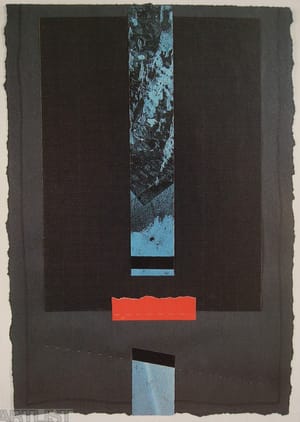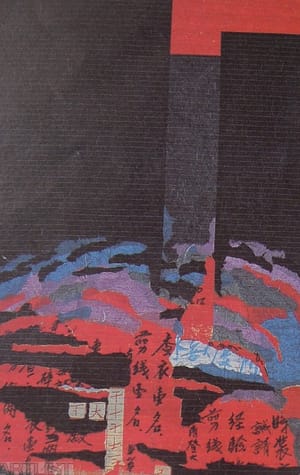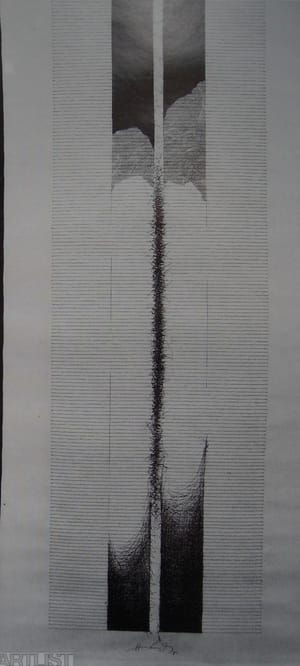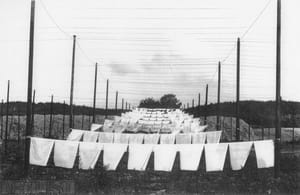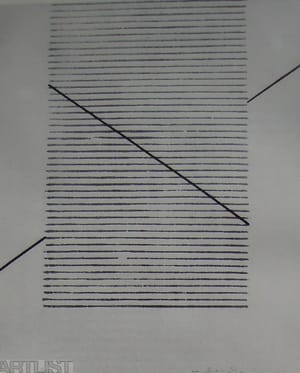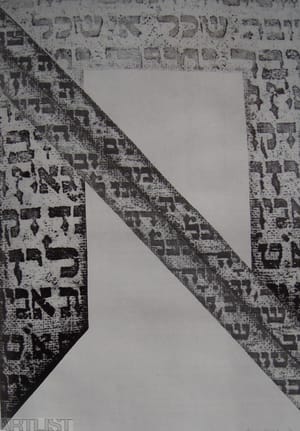- First Name
- Josef
- Surname
- Hampl
- Born
- 1932
- Birth place
- Praha
- CSU Library
- ↳ Find in the catalogue
About artist
Graphics is one of many art disciplines, which has not yet enjoyed full recognition within Czech free art. In spite of that, or perhaps because of it, the work of Josef Hampl within the Czech-Slovak context is exceptional since it crosses over the boundaries of this medium although it is partially based on it. In a similar way, he draws from the possibilities of collage, gesture painting, sculpture or tapestry. Josef Hampl never studied at any art school and during the 1950s he was forced to work in heavy industry despite his effort to work in his father’s tailor workshop. However, in addition to working in Poldi in Kladno, he also worked in Pragovka in Vysočany in Prague where there was a high concentration of Czech intellectuals and where Hampl met and became friends with Vladimír Boudník. At the same time the factories had art studios where it was possible to work on one’s own projects and meet other creative co-workers. For Hampl’s artistic expression the key influences were, rather than the introduction to Boudník’s structural graphics, Boudník’s later experiments with pieces of fabric and printed thread, as well as the subsequent meeting with Jiří Kolář. Kolář, who, for a long time, had been perceived as a poet even by his closest circle of friends, made collages and drawings already during the 1950s which he enhanced in the 1960’s by textiles, among other things. Josef Hampl did not start working with stitched collages until the beginning of the 1980s primarily because, as he himself admits, of health reasons – when he could no longer fully handle sculpting work. Hampl’s “stitched graphics” grow to human dimensions and remind of the increasingly valued and popular artistic tapestry widespread in Czechoslovakia since the 1970s the representative of which included Hampl’s peer Bohdan Mrázek among others.
In the 1970s Hampl participated in the mail art movement, and he also carried out and documented his own actions in nature. Perhaps his most famous action was Arrow from 1976 the photographic record of which – several tens of meters long white arrow floating in the background of dark landscape – makes a formal parallel to Hampl’s graphics. Later he participated in an unofficial exhibition in Mutějovická Chmelnice (1983) with a spatial installation. However, on the domestic scene his presentation was rather rare as opposed to the Italian or German scene where he significantly broke through in the 1980s even outside of the context of galleries focused on graphics.
The parallel in Hampl’s work with a certain aspect of Kolář’s work is not only in the material used but also in their work with script. Josef Hampl, however, uses script much more directly. He is interested in its aesthetical quality more than in the symbolic value. In the 1970s he uses frottage for Hebrew script from Jewish tombstones; around the year 2000 he is captivated by the Chinese script, similarly to artist Květa Pacovská.
The dominant factor in Hampl’s works is their verticality contrasting with horizontal stitched lines. His voluminous collages interconnecting fabric, found papers, slips and letters resemble ruled paper pages. Hampl only rarely fills the entire area and a significant formal element of his large collages is, similarly to the serigraphy of Zdeněk Sýkora or Milan Dobeš from the 1990s, emptiness.
As opposed to the above mentioned artists, Hampl’s abstract looking works are deeply symbolic and personal, like when he integrates letters from foreign countries addressed to himself, therefore bearing his name, which becomes part of the art work. Related to that are also the names of the works, which are supposed to divert the viewer from the abstract game of forms to the inwardness of life stories.
- Author of the annotation
- Tereza Hrušková
- Published
- 2016
CV
Studies:
1955–1960
School of applied arts, Prague, Jaroslav Masák
Employment:
1967–1990
Academy of Fine Arts Prague Akademie výtvarných umění, Praha
Exhibitions
- Solo exhibitions
-
2008
Josef Hampl: Šité koláže, Galerie Dion, Praha
2006
Josef Hampl: Monofrotáže z roku 1963, Galerie Ztichlá klika, Praha
2005
Josef Hampl: Šité koláže, Špačkova galerie v Lysolajích, Praha
2004
Josef Hampl: Šité koláže, Studio Paměť, společnost pro záchranu kulturních hodnot, Praha
Josef Hampl: Bílá na bílé, Obchod s ručním papírem, galerie a písařství, Praha
2002
Josef Hampl, Městský palác Templ (Galerie Templ), Mladá Boleslav
Josef Hampl, Galerie Via Art, Praha
2001
Josef Hampl: Bílá na bílé, Galerie Univerzity Pardubice, Pardubice
2000
Josef Hampl: Práce na papíře, Galerie Magna, Ostrava
1999
Josef Hampl: Šité koláže, Galerie Jiřího Jílka, Šumperk
Josef Hampl: Šité koláže, Sankturinovský dům, Kutná Hora
1998
Josef Hampl: Šité koláže, Galerie Nový Svět, Praha
1997
Josef Hampl, Galerie Gema, Praha
1996
Josef Hampl, Výstavní síň Synagoga, Hranice
1993
Josef Hampl: Bilance 1882 - 1992, Galerie Nová síň, Praha
1992
Josef Hampl: Šitá kresba a koláž, Studio Della, Ostrava
1991
Josef Hampl, Galerie Delta, Frýdek-Místek
Josef Hampl, Galerie výtvarného umění v Mostě, Most
1990
Josef Hampl: Dopisy, Ústav makromolekulární chemie (ÚMCH), výstavní síň, Praha
Josef Hampl: Šité koláže, Divadlo hudby OKS, Olomouc
1987
Josef Hampl: Drawings Sewings 1982 - 1986, The Club of Yo(u)ng Artists, Budapest
1986
Josef Hampl: Grafika, Junior klub Na chmelnici, Praha
Josef Hampl: Kresby a grafika, Těšínské divadlo, foyer, Český Těšín
Josef Hampl: Práce s papírem a kresba 1983-85, Galerie Opatov, Praha
1977
Josef Hampl: Obrazy z let 1976 - 1977, Ateliér Josefa Hampla, Praha
1972
Josef Hampl, Španělská synagoga, Praha
Josef Hampl: Plastiky, Výstavní síň divadla DKV, Tábor
1971
Josef Hampl: Grafika, kontratyp, Činoherní klub, Praha
Josef Hampl: Plastiky, Muzeum hlavního města Prahy, Praha
1970
Josef Hampl, Galerie Bode Glaub, Köln
1968
Josef Hampl: Grafika, plastika, Letohrádek Ostrov, Ostrov
1965
Josef Hampl: Obrazy, grafika, Viola, Praha
1963
Josef Hampl: Grafika, Závodní jídelna, Praha
Josef Hampl: Grafika, Kulturní středisko, Praha
Josef Hampl: Grafika, Městská knihovna Ostrov nad Ohří, Ostrov
- Group exhibitions not included in ARTLIST.
-
Selection:
2011
Citace a interpretace, Galerie NoD, Praha
2010
Česká koláž ze sbírky Pražské plynárenské, Galerie Smečky, Praha
2008
Kalendáře pro Jindru Štreita, Galerie Smečky, Praha
Moderní a poválečné umění, současné umění, fotografie, Galerie 5. patro, Praha
Soustředěný pohled / Focused View. Grafika 60. let ze sbírek členských galerií Rady galerií České republiky, Oblastní galerie Vysočiny v Jihlavě, Jihlava
2007
Moderní a poválečné umění. Současné umění. Fotografie, Galerie Louvre, Praha
Soustředěný pohled / Focused View. Grafika 60. let ze sbírek členských galerií Rady galerií České republiky, Oblastní galerie v Liberci, Liberec
Členská výstava Umělecké besedy, Novoměstská radnice, Praha
Hommage á Kassák 120/40, Galéria Z, Bratislava
Umělecká beseda: Vědomí o člověku, Mánes, Praha
Umělecká beseda: Vědomí o člověku, Výstavní síň Masné krámy, Plzeň
Seskupení 5 + 5. Obrazy, koláže, kresby, grafiky, Trigon Gallery, Plzeň
Členská výstava Umělecké besedy, Muzeum a galerie Orlických hor, Rychnov nad Kněžnou
Josef Hampl, Josef Honys: Setkání šicího stroje s lokomotivou, Galerie Smečky, Praha
Česká koláž a asambláž, Пермскоя художествення галерея, Perm
(Пермь)
2006
Konfrontace 5: Darek Orwat, Josef Hampl, Polský institut v Praze, Praha
Česká grafika 60. let, Galerie Hollar, Praha
Kalendáře pro Jindru Štreita, Dům umění, přednáškový sál, Ostrava
2005
Pražské ateliéry, Novoměstská radnice, Praha
4. benefiční aukce výtvarných děl pro akci Cihla, předaukční prohlídka, Galerie Gambit, Praha
Œuvres graphiques des années 60, Centre tchèque Paris (České centrum Paříž), Paris
Art Prague. 4. veletrh současného umění / 4th International Contemporary Art Fair, Mánes, Praha
Exprese / Expressiveness, České muzeum výtvarných umění, výstavní prostory, Praha
2004
7. aukční salon výtvarníků, 372 dárců pro konto Bariéry, Karolinum, Praha
Kresba, kresba... Česká kresba 80. let 20. století ze sbírek členských galerií RG ČR, Výstavní síň Masné krámy, Plzeň
Výstava výtvarných prací z Mezinárodního plenéru Pardubice 2002, Východočeské muzeum, Pardubice
Art Prague. 3. veletrh současného umění / 3th Contemporary Art Fair, Praha, Praha
2003
Prazdroj české kultury. Umění inspirované pivem, Mánes, Praha
Minisalon, Centre tchèque Paris (České centrum Paříž), Paris
2002
Česká grafika. Půlstoletí proměn moderní grafické tvorby, Mánes, Praha
Minisalon, Majapahit Mandarin Hotel, Surabaya
Minisalon, Museum Puri Lukisan, Ubud
Minisalon, Galeri Nasional Indonesia, Jakarta
2001
Súčasná česká serigrafia, Štátna galéria, Banská Bystrica
2000
Na cestě ke stálé expozici: Současná česká malba, plastika..., Muzeum umění Benešov, Benešov
Setkání výtvarníků konstruktivní orientace, Dejvická galerie Vincence Kramáře, Praha
Umělecká beseda 1999/2000, Mánes, Praha
Česká serigrafie, Dům umění, Zlín
...a poletíme dál..., Mánes, horní sál, Praha
Současná česká serigrafie, Galerie moderního umění v Hradci Králové, Hradec Králové
1999
Česká serigrafie, Staroměstská radnice, Sál architektů, 4. patro, Praha
Súčasné české umenie (zo súkromej zbierky), Galéria Z, Bratislava
1998
4. aukční salon výtvarníků, 312 dárců pro konto Bariéry, Karolinum, Praha
Moje mořské dobrodružství začíná..., Mánes, horní sál, Praha
Minisalon, Bibliotheque Royal de Belgique, Brusel
1997
Česká koláž, Palác Kinských, Praha
3. aukční salon výtvarníků, 223 dárců pro konto Bariéry, Karolinum, Praha
Umění zastaveného času / Art when time stood still, Česká výtvarná scéna 1969-1985, Státní galerie výtvarného umění v Chebu, Cheb
Umění zastaveného času / Art when time stood still, Česká výtvarná scéna 1969-1985, Brno (Brno-město), Brno
Z nesbírky Marcely Pánkové, Galerie U Kamene, Cheb (Cheb)
Minisalon, Pražský hrad, Praha
Z nesbírky Marcely Pánkové, Galerie Hermit - Studio 600, Praha
Z nesbírky Marcely Pánkové, Galerie bratří Čapků, Praha
1996
Bienále české grafiky Ostrava 1996, Dům umění, Ostrava
Umění zastaveného času / Art when time stood still, Česká výtvarná scéna 1969-1985, Praha, Praha
I. nový zlínský salon, Zlín, Zlín
Přírůstky 1991 - 1995, Dům umění, Ostrava
Minisalon, McKissick Museum, Columbia
Minisalon, University Art Gallery, Nord Dartmouth
Minisalon, The Museum of Fine Arts, St. Petersburg
Minisalon, Gallery of Fine Arts, Forth Myers
1995
2. aukční salon výtvarníků, 195 dárců pro konto Bariéry, Karolinum, Praha
Umělecká beseda 1995, Mánes, Praha
Umění frotáže, Severočeská galerie výtvarného umění v Litoměřicích, Litoměřice
Minisalon, Indianapolis Musem of Art, Indianapolis
Minisalon, Chicago Cultural Center, Chicago
Minisalon, Jonson Gallery, Albuquerque
1994
Solidart 2000: Katalánsko-slovensko-česká výstava kreseb a grafik, Salon, Kabinet, Olomouc
Setkání IV - Zrcadlení, Galerie R, Praha
Informační konzerva, Galerie mladých, U Řečických, Praha
Česká grafika šedesátých let, Palác Kinských, Praha
Minisalon, Courtyard Gallery, New York
Minisalon, Contemporary Arts Center, Cincinnati
Minisalon, Art and Culture Centre, Hollywood
1993
Minisalon, Musée des Beaux Arts, Mons
1992
Vysočanský okruh Vladimíra Boudníka, Palác Kinských, Praha
Kresby v labyrintu, Divadlo Labyrint, Praha
Minisalon, Galerie Nová síň, Praha
Česká kresba, Galerie R, Praha
Nová geometrie, Národní technické muzeum, Praha
1991
Malý formát 91, Galerie Chodovská tvrz, Praha
Umění akce, Mánes, Praha
Šedá cihla 78/1991, Galerie U Bílého jednorožce, Klatovy
Alternativy české a slovenské tapiserie, Dům umění města Brna, Brno
Šedá cihla 78/1991, Dům umění města Opavy, Opava
1990
Kontrasty, Výstavní síň Ústředí lidové a umělecké výroby, Praha
90 autorů v roce ´90, Palác kultury, Praha
1989
Svornost 89', Hostinec Svornost, Dolní Počernice
Čtyřverší, Galerie Studánka, Brno
Současná česká grafika, Mánes, Praha
Josef Hampl, Věra Boudníková, Zámek Sokolov, Sokolov
1988
Možnosti vlákna, Galerie v předsálí, Blansko
Pět let Galerie H, Galerie H , Kostelec nad Černými lesy
Forum 1988, Holešovická tržnice, Praha
Salón pražských výtvarných umělců '88, Park kultury a oddechu Julia Fučíka, Praha
1987
Klub der Konkretisten 1967 - 1987, Objekte und Grafiken, Galerie Rafay, Kronberg
Hana Hamplová: Fotografie, Josef Hampl: Kresby - šití, Sovinec, Sovinec
1985
Barevná socha, Galerie H , Kostelec nad Černými lesy
Setkání - mikrosvět, Galerie H , Kostelec nad Černými lesy
1984
Josef Hampl, Svatopluk Klimeš, Hala ústavu SUDOP, Praha
Čtyřverší, Galerie H , Kostelec nad Černými lesy
Velká kresba, Galerie H , Kostelec nad Černými lesy
1983
Krabičky, Galerie H , Kostelec nad Černými lesy
1967
Nové výtvarné postupy, Dům umění města Brna, Brno
Hosté Hollara, Galerie Hollar, Praha
1965
Grafika 65, Vlastivědné museum, Písek
